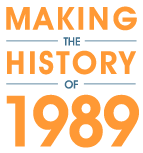Scholar Interviews
Questions
- What were your experiences of 1989?
- How have your ideas changed?
- How did you research 1989?
- Did your research lead to a new interpretation?
- Is there one moment that stands out for you personally?
- One crucial moment of 1989?
- What led to the Round Table Talks?
- What sources help us understand the strikes?
- What is significant about the leaflet?
- How do you analyze the leaflet?
- Does this poem help explain the strike?
- What is remarkable about the poem and the leaflet together?
- What is significant about the poem?
- How should students interpret the poem?
- How is Solidarity viewed today?
How is Solidarity viewed today?
Transcription
My looking at these documents sort of changed the way I thought about the role of workers in 1989, but the story of Solidarity has also changed so much. So that even through the first half of the 1990s, it was easier to look at Solidarity and its involvement in 1989 in a very positive light. Solidarity’s not only victorious, but then its leader becomes president of Poland and maybe he’s kind of an uncouth figure, Lech Walesa, but nonetheless, there’s a kind of Solidarity victorious story.
And then over 10 or so years from 1995, as first the Communists win an election and then a Communist candidate or and then a[n] ex-Communist candidate defeats Lech Walesa and becomes president. And then Solidarity moves farther and farther to the right and becomes more of a traditional trade union but with a distinctly nationalistic and Catholic orientation that was always there but was not as evident.
Today, when one talks about Solidarity, the response in Poland is kind of scorn and that makes it so much more difficult to look at its role at the time. And so I feel that I was rather fortunate first of all, to be there to be able look at Solidarity and the movements around it at a moment when they were still sort of unsullied but also to be able to interview people at a moment when the cynicism was not so deep.
The job of a historian is to recover what really was there, you know, take that moment of optimism at face value and take it quite seriously and not as something that it was foolish or utopian.
How to Cite
Padraic Kenney, interview, "How is Solidarity viewed today?" Making the History of 1989, Item #596, https://chnm.gmu.edu/1989/items/show/596 (accessed May 28 2021, 3:25 pm).
